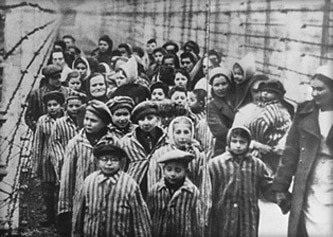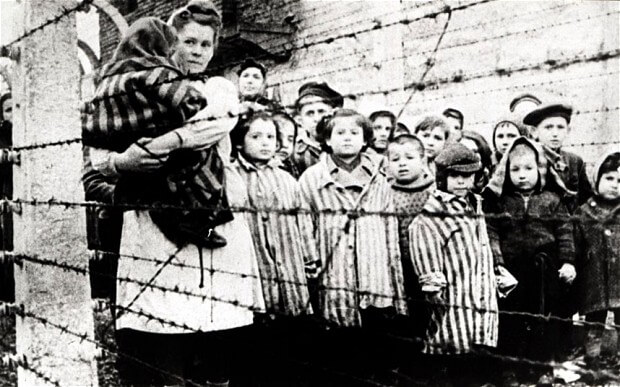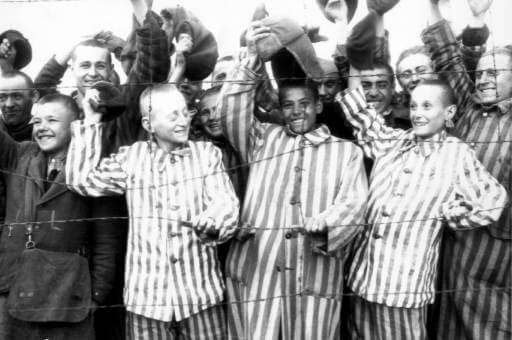The SS and their accomplices murdered approximately 1.5 million Jewish children, thousands of Roma (Gypsy) children, German children who had mental or physical disabilities and Polish children.
The fate of Jewish and non-Jewish children fell into the following categories:
(i) killed immediately upon arrival at the death camps — toddlers to 12 years old;
(ii) killed immediately after birth — babies in camps, particularly in Ravensbrück (the women’s camp) and in the women’s camp within Auschwitz-Birkenau;
(iii) selected for forced labour or for medical experiments — adolescents aged 12 to 18;
(iv) hidden by prisoners in concentration camps or by non-Jews in Nazi-occupied territories;
(v) escapees from ghettos who joined partisan groups in the forests of eastern Poland or became members of Polish or Jewish underground organisations; and
(vi) massacred in reprisals such as at Lidice in Czechoslovakia and Oradour-sur-Glane in France.
In spite of the constant Aktions (seizing of Jews for forced labour or deportation) that established an ongoing pattern of murder and devastation in German-established ghettos, children displayed a remarkable ability to adapt. They read, attended underground schools, had music lessons and participated in cultural events — recitals, puppet shows and plays, often performing in their own productions. Every effort was made by their parents to maintain a semblance of their pre-war lives.
However, children were the most vulnerable, the most likely to perish from hunger, disease, poverty and inadequate shelter. They perished by the hundreds of thousands even before deportations to the gas chambers began in 1942. The German authorities were indifferent to their plight as they regarded them as unproductive and therefore “useless eaters”. Children under 12 were too young to be assigned to forced labour and hence they were the first group to be selected, along with the sick, the frail and the elderly for the gas chambers. Jewish councils (Judenräte) at times selected children as the first group for transportation. The head of the Judenrat in Lodz, Chaim Rumkowski, was faced with such “choiceless choices”. Janusz Korczak (pen name of Henryk Goldszmit), director of the orphanage in the Warsaw Ghetto, refused to be separated from the children in his care, however, and when they were selected for deportation he insisted on staying with them on the transport to the Treblinka extermination camp and into the gas chambers, sharing their fate.
On arrival at the death camps, the majority of children (usually under the age of 12) were sent directly to the gas chambers. Although Jewish adolescents (aged 13-18) were often not gassed immediately, but selected for forced labour, their long-term survival was rare, as most died from exhaustion and disease.
Non-Jewish children from particular groups were also targeted. Roma (Gypsy) children were murdered at Auschwitz II; thousands of German children were killed in euthanasia operations; and at times, as in Lidice and Oradour-sur-Glane, children were murdered in reprisals. Children who were imprisoned in concentration camps were used by SS physicians and medical researchers in medical experiments that often resulted in deformities and death. Twins in particular were chosen for such experiments.
In the SS initiative to “reclaim Aryan blood”, hundreds of children in occupied Poland and in the occupied areas of the former Soviet Union were kidnapped and sent to Germany to be adopted by “racially-superior” German families. The Einsatzgruppen (mobile killing squads) shot thousands of children in front of mass graves in German-occupied Poland and in the occupied territories of the former Soviet Union.
Despite these measures, many children found ways to survive. In the ghettos they were extensively involved in smuggling operations, even though this was punishable by death. The lives of many people were either prolonged or saved due to the bravery of ghetto children. Many children, especially, teenagers, were active in underground resistance initiatives. Some helped to distribute underground publications, others served as couriers transmitting illegal documents and maintaining communication channels between ghettos. While the leaders of the Jewish underground combat units tended to be young adults, the rank and file was often made up of adolescents. At times, children were smuggled out of ghettos by female couriers of the underground youth movements and hidden on the Polish side by non-Jews. Many escaped with parents or relatives to the forests and joined Jewish partisan units or family camps.
Between 1938 and 1940, the Kindertransport (Children’s Transport) rescue missions brought about 10,000 refugee Jewish children to Great Britain from Nazi Germany and German-occupied territories. Anne Frank and many other Jewish children were hidden by non-Jews or in monasteries by Catholic priests and nuns. From 1942 to1944, almost the entire Protestant population of the French village of Le Chambon-sur-Lignon provided refuge for Jewish children.
In the aftermath of World War II, survivors and displaced persons (DPs) searched Europe for missing children and family members. Thousands of orphaned children found themselves in displaced persons’ camps. Eventually, some made their way to Jewish communities in then-Palestine and many more migrated to Israel after its establishment in 1948.
Recommended Reading
Dwork, D. (1991). Children With A Star. New Haven: Yale University Press.
Eisenberg, A. (1982). The Lost Generation: Children and the Holocaust. New York: Pilgrim.
Fast, V. K. (2011). Children’s Exodus: A Short History of the Kindertransport. London: I. B. Tauris.
Heberer, P. (2000). Children During the Holocaust: Documenting Life and Destruction. Maryland: Alta Mira Press.
Lukas, R. C. (2001). Did the Children Cry? Hitler’s War Against Jewish and Polish Children 1939-1945. New York: Hippocrene Books.
Marks, J. (1993). The Hidden Children: The Survivors of the Holocaust. New York: Fawcett.
Nieuwsma, M. J. (1998). Kinderlager: An Oral History of Young Holocaust Survivors. New York: Holiday House.
Pettit, J. (1995). A Time to Fight Back: True Stories of Children’s Resistance During World War II. London: Macmillan.
Slonim, E. (2014). Gazing At The Stars: Memories of a Child Survivor. Victoria: Black Inc.
Sonnert, G. & Holton, G. (2006). What Happened to the Children Who Fled Nazi Persecution? Palgrave: Macmillan.
Zahra, T. (2011). The Lost Children: Reconstructing Europe’s Families After WWII. Cambridge: Harvard University Press.
Ziemian, J. (2005). The Cigarette Sellers of Three Crosses Square. Middlesex: Vallentine Mitchell.



